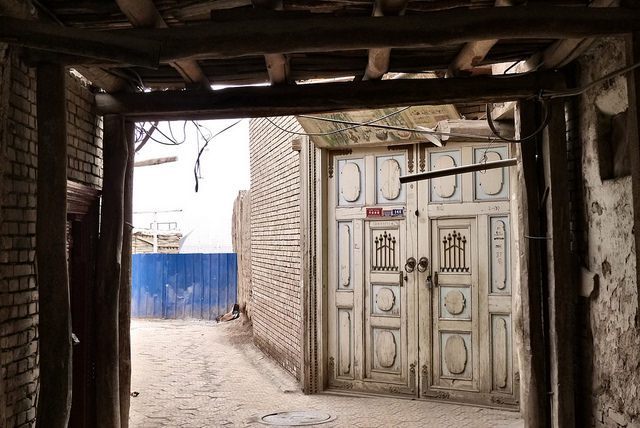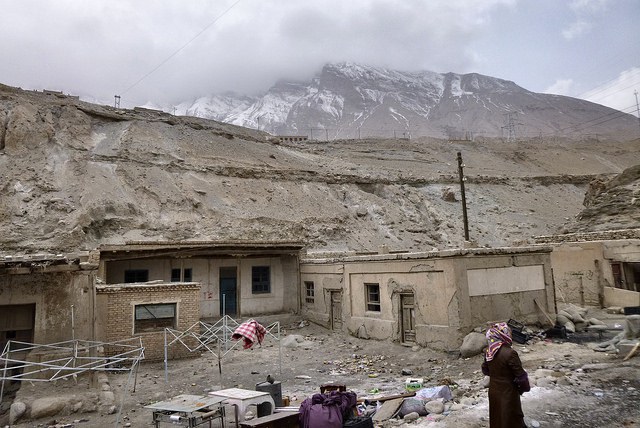A Journey into Xinjiang, in the footsteps of the screaming demons
di Piotr,
farfalleetrincee, May 11, 2016.
 |
This Chinese region links two very different civilizations:
proper China and Central Asia. Xinjiang is perhaps one of the most
evocative places around the world, for its History – of here the
Silk Road passed – and for its being crossroad of
peoples and cultures.
Xinjiang is a region not so simple to travel
in, but able to uncover a multitude of surprises to
everyone adventuring in its discovery.
On the routes of ancient
caravans and treasure seekers, a land that will enter directly in
your soul, overcoming it.
Xinjiang is essentially divided
in two parts: the Northern, roughly the Dzungaria, and the
Tarim Basin, inside which we can found one of most famous and feared
deserts of the planet: the Taklamakan. These are two very different
areas; Dzungaria, with its forests and lakes, is
stretched up towards the Altai Mountains, wedged between Russia,
Kazakhstan and Mongolia, the Tarim Basin is instead marked by a
prevailing desert landscape, surrounded by mountain ranges as the
Thian Shan to the north, the Pamirs to the west and
the Kunlun to the south.
This is an area remote and desolate but
deeply suggestive.
 |
Natural environments make Xinjiang a
unique destination for visitors; we can find five National
Parks dotting the Autonomous Region: Bosten and Sayram around the
Tianchi Lakes, the one in the Kumtag Desert and the Lopren Chunzai.
However, to do unequalled this region is the human
environment, whit its numerous minorities and its traditions
recalling directly the Silk Road.
Here peoples live in typically
Central Asians harsh climates, characterized by extremely rigid
winters and scorching summers. It’s really a place
not suitable for everyone.
Legends tell in the Taklamakan you can
heard demons screaming, during terrible sandstorms
that here have buried entire empires in the past.
This desert is
certainly one of the most fascinating aspects of Xinjiang.
The
Taklamakan circumnavigation is an unforgettable experience.
You can start from Turpan, historically the gateway to the region,
continuing then in direction of Kuqa and its grottoes housing
some unrivalled Buddha’s representations.
 |
After this, once in
Kashgar you can also reach the Pakistan through the Karakoram
Highway, a hazardous-charm-road.
From Kashgar you can close the
ring around the Taklamakan as well, along the route of the
south side of the desert, an even more remote and timeless trip.
Here
you can visit Hotan, a town famous for its precious jade, pass other
small city and arrive in Qiemo, from where the
perhaps most beautiful way crossing the Taklamakan starts; a road
smaller and closer to the dunes than others and finishing in Korla, a
very nice city.
From Qiemo you can decide to leave for
Golmud in Qinghai as well, a long and difficult journey. Situated at an angle of the desert,
Korla is the capital of the Bayangolin Prefecture,
an area of Mongolian ethnicity and ideal place to recover an urban
dimension after the immersion deep in the Xinjiang.
Korla has a
superb museum and you can visit the evocative “Iron Door
Pass” just outside the town. Korla is well-connected to
Urumqi, capital of Xinjiang and modern city linking together the
different parts of the Autonomous Region. Also of
note, here again, the presence of a unforgettable museum dedicated to
the twelve minority of Xinjiang.
 |
Xinjiang is this and much
more. You should think to the ghost towns of Jiaohe e
Gaochan near Turpan, or the legendary Lou Lan that only can be
visited after obtaining expensive authorisations. The History of
Xinjiang has seen clashes between nomads and settlers, cultures
proceeding on a camel along the caravan routes,
Islam displacing Buddhism and the existence of even older
communities.
Visiting Xinjiang means to get soaked in the flow of
time, where tradition and modernity contradict each
other, where Uyghurs and Hans attempt to cohabit.
Xinjiang is life,
true life.


